Acura MDX 2011 Service Manual
Manufacturer: ACURA, Model Year: 2011, Model line: MDX, Model: Acura MDX 2011Pages: 609, PDF Size: 12.7 MB
Page 41 of 609
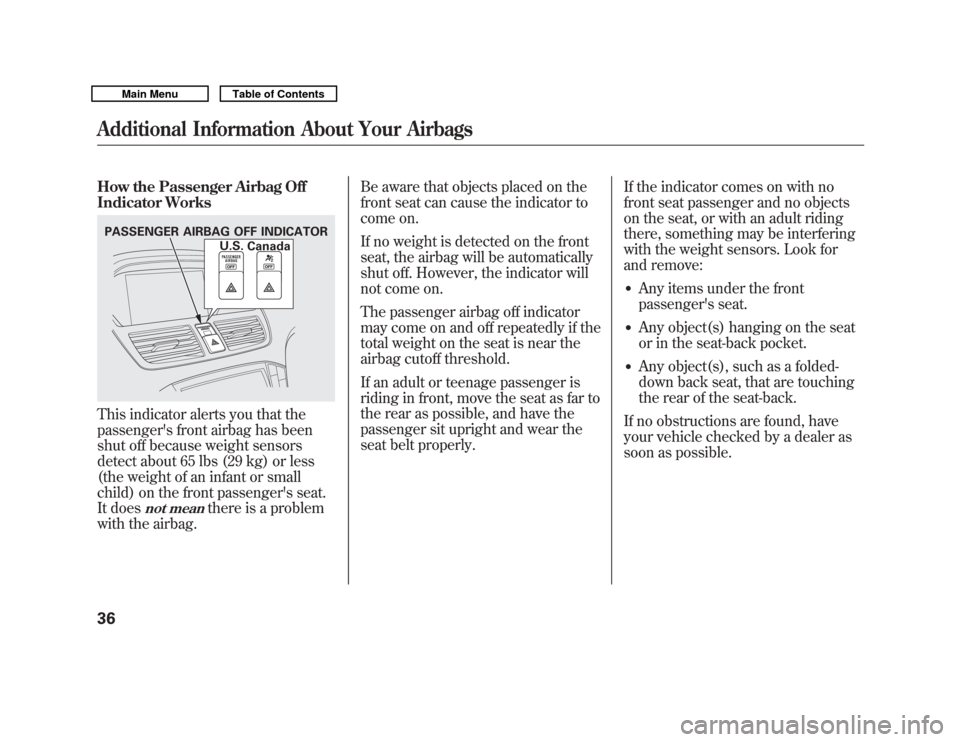
How the Passenger Airbag Off
Indicator WorksThis indicator alerts you that the
passenger's front airbag has been
shut off because weight sensors
detect about 65 lbs (29 kg) or less
(the weight of an infant or small
child) on the front passenger's seat.
It does
not mean
there is a problem
with the airbag. Be aware that objects placed on the
front seat can cause the indicator to
come on.
If no weight is detected on the front
seat, the airbag will be automatically
shut off. However, the indicator will
not come on.
The passenger airbag off indicator
may come on and off repeatedly if the
total weight on the seat is near the
airbag cutoff threshold.
If an adult or teenage passenger is
riding in front, move the seat as far to
the rear as possible, and have the
passenger sit upright and wear the
seat belt properly.
If the indicator comes on with no
front seat passenger and no objects
on the seat, or with an adult riding
there, something may be interfering
with the weight sensors. Look for
and remove:
●
Any items under the front
passenger's seat.
●
Any object(s) hanging on the seat
or in the seat-back pocket.
●
Any object(s), such as a folded-
down back seat, that are touching
the rear of the seat-back.
If no obstructions are found, have
your vehicle checked by a dealer as
soon as possible.
PASSENGER AIRBAG OFF INDICATOR U.S.CanadaAdditional Information About Your Airbags3610/06/29 11:59:04 11 ACURA MDX MMC North America Owner's M 50 31STX640 enu
Page 42 of 609
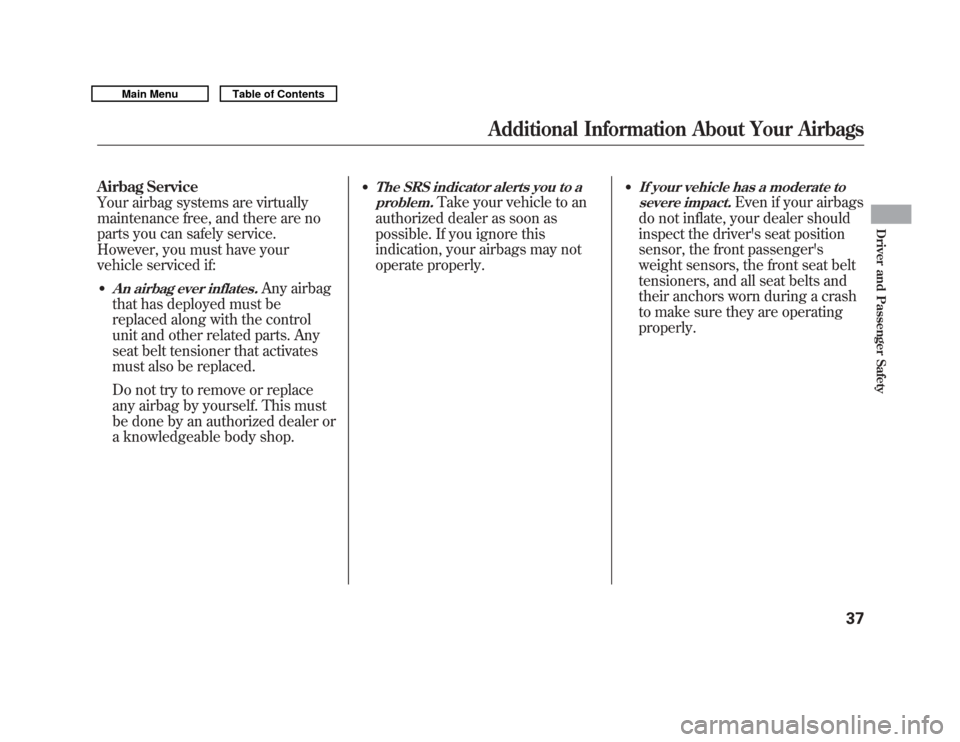
Airbag Service
Your airbag systems are virtually
maintenance free, and there are no
parts you can safely service.
However, you must have your
vehicle serviced if:●
An airbag ever inflates.
Any airbag
that has deployed must be
replaced along with the control
unit and other related parts. Any
seat belt tensioner that activates
must also be replaced.
Do not try to remove or replace
any airbag by yourself. This must
be done by an authorized dealer or
a knowledgeable body shop.
●
The SRS indicator alerts you to a
problem.
Take your vehicle to an
authorized dealer as soon as
possible. If you ignore this
indication, your airbags may not
operate properly.
●
If your vehicle has a moderate to
severe impact.
Even if your airbags
do not inflate, your dealer should
inspect the driver's seat position
sensor, the front passenger's
weight sensors, the front seat belt
tensioners, and all seat belts and
their anchors worn during a crash
to make sure they are operating
properly.
Additional Information About Your Airbags
37
Driver and Passenger Safety
10/06/29 11:59:04 11 ACURA MDX MMC North America Owner's M 50 31STX640 enu
Page 43 of 609
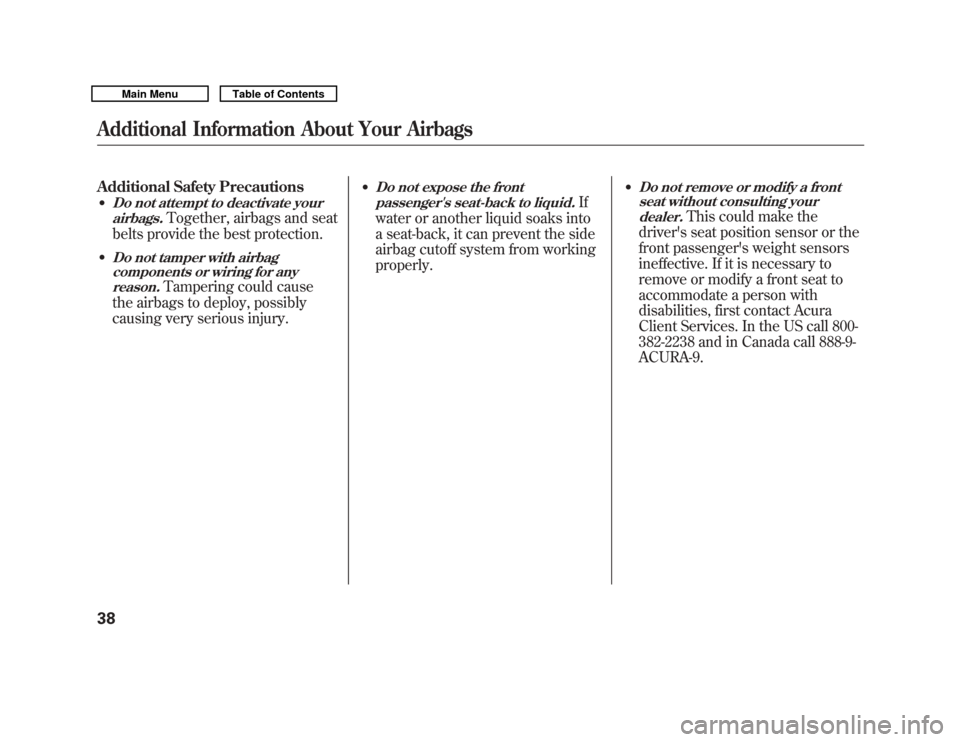
Additional Safety Precautions●
Do not attempt to deactivate yourairbags.
Together, airbags and seat
belts provide the best protection.
●
Do not tamper with airbag components or wiring for any
reason.
Tampering could cause
the airbags to deploy, possibly
causing very serious injury.
●
Do not expose the front
passenger's seat-back to liquid.
If
water or another liquid soaks into
a seat-back, it can prevent the side
airbag cutoff system from working
properly.
●
Do not remove or modify a front seat without consulting your
dealer.
This could make the
driver's seat position sensor or the
front passenger's weight sensors
ineffective. If it is necessary to
remove or modify a front seat to
accommodate a person with
disabilities, first contact Acura
Client Services. In the US call 800-
382-2238 and in Canada call 888-9-
ACURA-9.
Additional Information About Your Airbags3810/06/29 11:59:04 11 ACURA MDX MMC North America Owner's M 50 31STX640 enu
Page 44 of 609
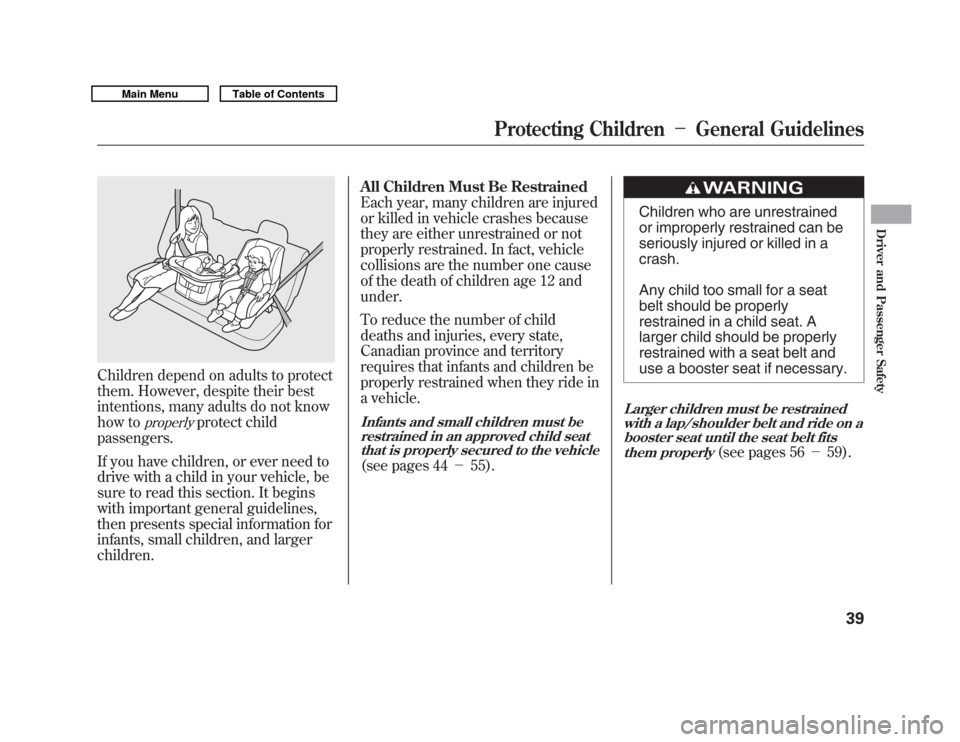
Children depend on adults to protect
them. However, despite their best
intentions, many adults do not know
how to
properly
protect child
passengers.
If you have children, or ever need to
drive with a child in your vehicle, be
sure to read this section. It begins
with important general guidelines,
then presents special information for
infants, small children, and larger
children. All Children Must Be Restrained
Each year, many children are injured
or killed in vehicle crashes because
they are either unrestrained or not
properly restrained. In fact, vehicle
collisions are the number one cause
of the death of children age 12 and
under.
To reduce the number of child
deaths and injuries, every state,
Canadian province and territory
requires that infants and children be
properly restrained when they ride in
a vehicle.
Infants and small children must be
restrained in an approved child seatthat is properly secured to the vehicle(see pages 44 -55).
Children who are unrestrained
or improperly restrained can be
seriously injured or killed in a
crash.
Any child too small for a seat
belt should be properly
restrained in a child seat. A
larger child should be properly
restrained with a seat belt and
use a booster seat if necessary.
Larger children must be restrained
with a lap/shoulder belt and ride on a
booster seat until the seat belt fits
them properly
(see pages 56 -59).
Protecting Children -General Guidelines
39
Driver and Passenger Safety
10/06/29 11:59:04 11 ACURA MDX MMC North America Owner's M 50 31STX640 enu
Page 45 of 609
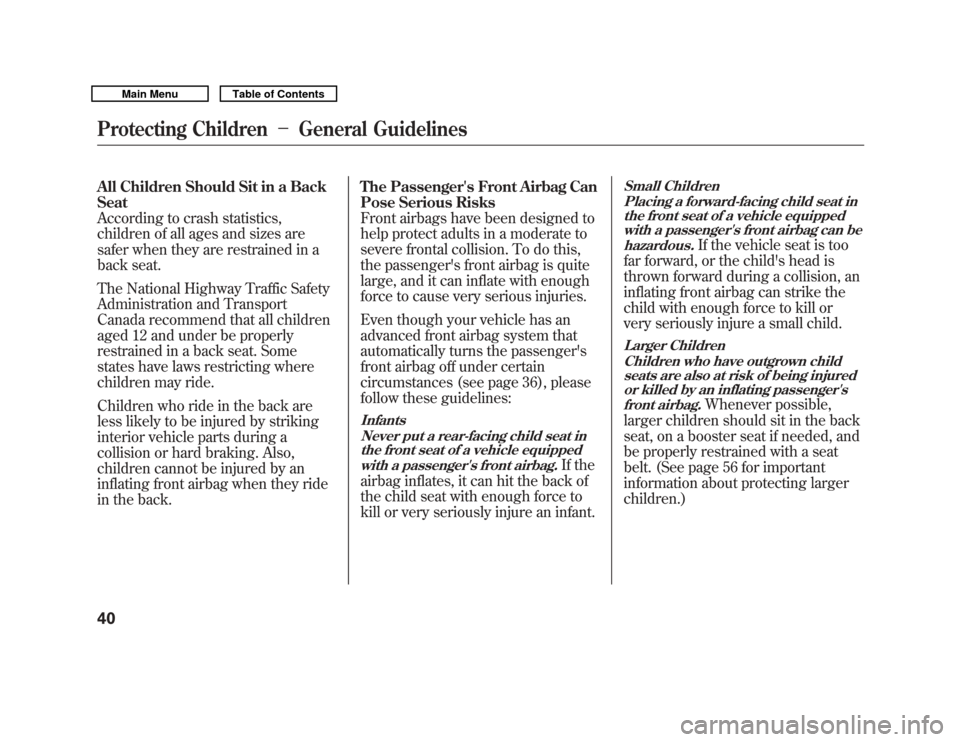
All Children Should Sit in a Back
Seat
According to crash statistics,
children of all ages and sizes are
safer when they are restrained in a
back seat.
The National Highway Traffic Safety
Administration and Transport
Canada recommend that all children
aged 12 and under be properly
restrained in a back seat. Some
states have laws restricting where
children may ride.
Children who ride in the back are
less likely to be injured by striking
interior vehicle parts during a
collision or hard braking. Also,
children cannot be injured by an
inflating front airbag when they ride
in the back.The Passenger's Front Airbag Can
Pose Serious Risks
Front airbags have been designed to
help protect adults in a moderate to
severe frontal collision. To do this,
the passenger's front airbag is quite
large, and it can inflate with enough
force to cause very serious injuries.
Even though your vehicle has an
advanced front airbag system that
automatically turns the passenger's
front airbag off under certain
circumstances (see page 36), please
follow these guidelines:
Infants
Never put a rear-facing child seat inthe front seat of a vehicle equipped
with a passenger's front airbag.
If the
airbag inflates, it can hit the back of
the child seat with enough force to
kill or very seriously injure an infant.
Small Children
Placing a forward-facing child seat inthe front seat of a vehicle equipped
with a passenger's front airbag can be
hazardous.
If the vehicle seat is too
far forward, or the child's head is
thrown forward during a collision, an
inflating front airbag can strike the
child with enough force to kill or
very seriously injure a small child.
Larger Children
Children who have outgrown childseats are also at risk of being injuredor killed by an inflating passenger's
front airbag.
Whenever possible,
larger children should sit in the back
seat, on a booster seat if needed, and
be properly restrained with a seat
belt. (See page 56 for important
information about protecting larger
children.)
Protecting Children -General Guidelines4010/06/29 11:59:04 11 ACURA MDX MMC North America Owner's M 50 31STX640 enu
Page 46 of 609
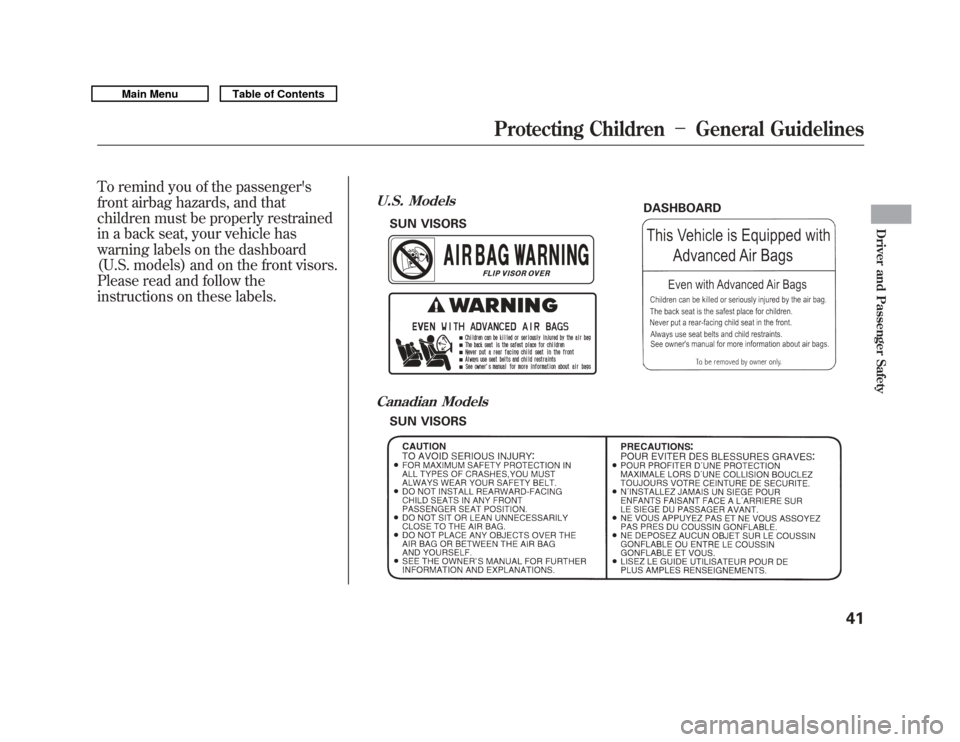
To remind you of the passenger's
front airbag hazards, and that
children must be properly restrained
in a back seat, your vehicle has
warning labels on the dashboard
(U.S. models) and on the front visors.
Please read and follow the
instructions on these labels.
U.S. Models
SUN VISORSDASHBOARD
Canadian Models
SUN VISORS
Protecting Children
-General Guidelines
41
Driver and Passenger Safety
10/06/29 11:59:04 11 ACURA MDX MMC North America Owner's M 50 31STX640 enu
Page 47 of 609
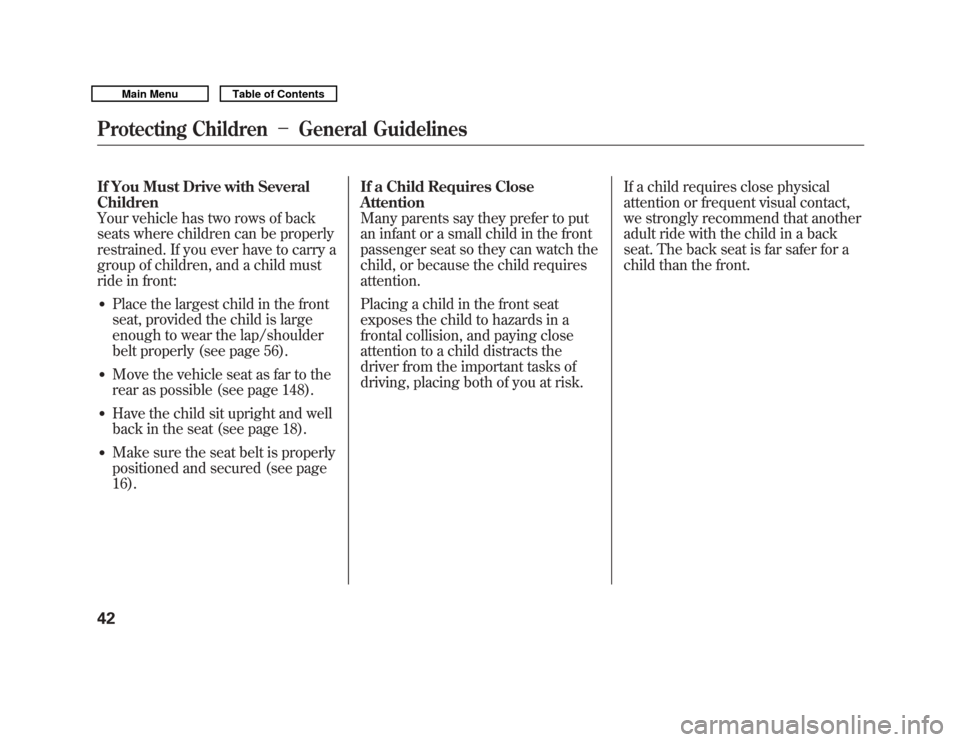
If You Must Drive with Several
Children
Your vehicle has two rows of back
seats where children can be properly
restrained. If you ever have to carry a
group of children, and a child must
ride in front:●
Place the largest child in the front
seat, provided the child is large
enough to wear the lap/shoulder
belt properly (see page 56).
●
Move the vehicle seat as far to the
rear as possible (see page 148).
●
Have the child sit upright and well
back in the seat (see page 18).
●
Make sure the seat belt is properly
positioned and secured (see page
16).If a Child Requires Close
Attention
Many parents say they prefer to put
an infant or a small child in the front
passenger seat so they can watch the
child, or because the child requires
attention.
Placing a child in the front seat
exposes the child to hazards in a
frontal collision, and paying close
attention to a child distracts the
driver from the important tasks of
driving, placing both of you at risk.
If a child requires close physical
attention or frequent visual contact,
we strongly recommend that another
adult ride with the child in a back
seat. The back seat is far safer for a
child than the front.
Protecting Children
-General Guidelines4210/06/29 11:59:04 11 ACURA MDX MMC North America Owner's M 50 31STX640 enu
Page 48 of 609
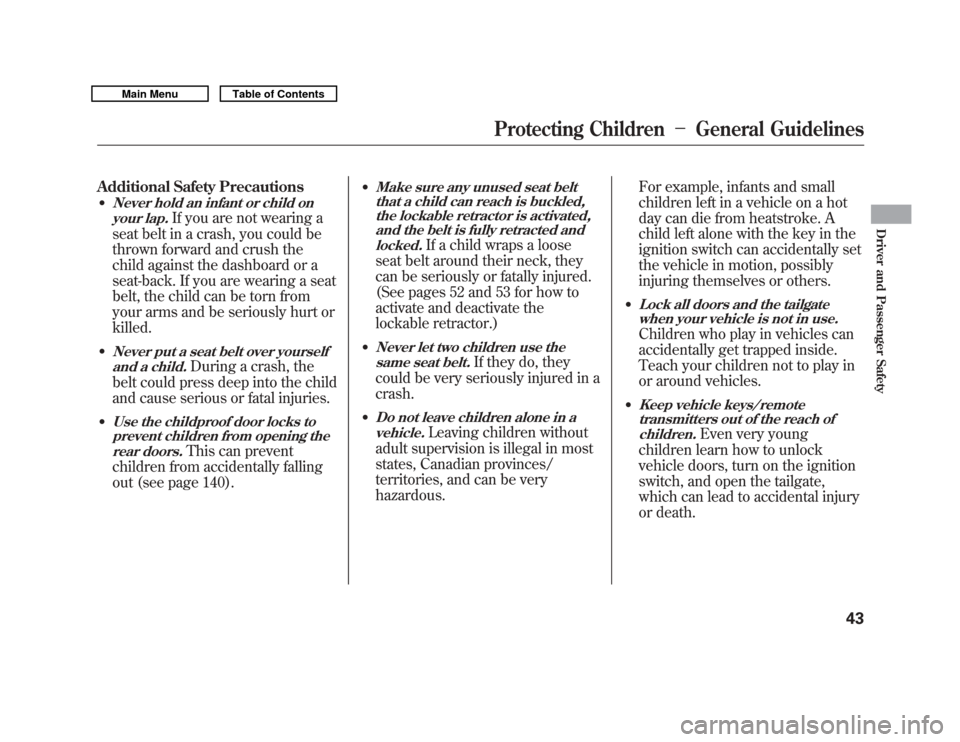
Additional Safety Precautions●
Never hold an infant or child onyour lap.
If you are not wearing a
seat belt in a crash, you could be
thrown forward and crush the
child against the dashboard or a
seat-back. If you are wearing a seat
belt, the child can be torn from
your arms and be seriously hurt or
killed.
●
Never put a seat belt over yourself
and a child.
During a crash, the
belt could press deep into the child
and cause serious or fatal injuries.
●
Use the childproof door locks to prevent children from opening the
rear doors.
This can prevent
children from accidentally falling
out (see page 140).
●
Make sure any unused seat belt that a child can reach is buckled,the lockable retractor is activated,
and the belt is fully retracted and
locked.
If a child wraps a loose
seat belt around their neck, they
can be seriously or fatally injured.
(See pages 52 and 53 for how to
activate and deactivate the
lockable retractor.)
●
Never let two children use the
same seat belt.
If they do, they
could be very seriously injured in a
crash.
●
Do not leave children alone in a
vehicle.
Leaving children without
adult supervision is illegal in most
states, Canadian provinces/
territories, and can be very
hazardous. For example, infants and small
children left in a vehicle on a hot
day can die from heatstroke. A
child left alone with the key in the
ignition switch can accidentally set
the vehicle in motion, possibly
injuring themselves or others.
●
Lock all doors and the tailgate
when your vehicle is not in use.Children who play in vehicles can
accidentally get trapped inside.
Teach your children not to play in
or around vehicles.
●
Keep vehicle keys/remotetransmitters out of the reach of
children.
Even very young
children learn how to unlock
vehicle doors, turn on the ignition
switch, and open the tailgate,
which can lead to accidental injury
or death.
Protecting Children -General Guidelines
43
Driver and Passenger Safety
10/06/29 11:59:04 11 ACURA MDX MMC North America Owner's M 50 31STX640 enu
Page 49 of 609
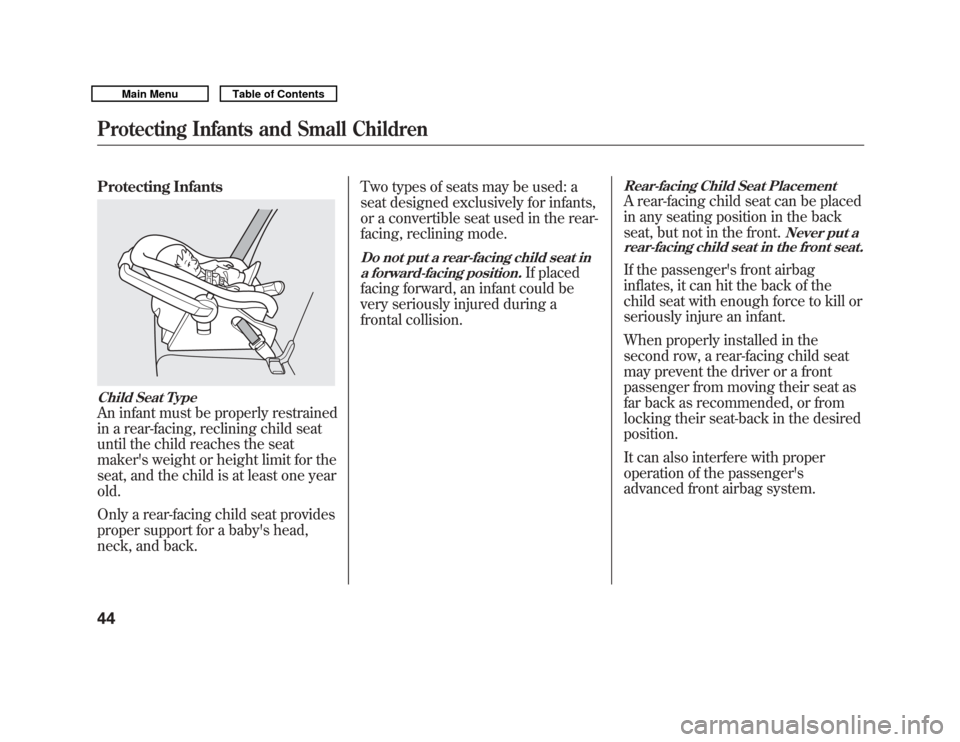
Protecting InfantsChild Seat TypeAn infant must be properly restrained
in a rear-facing, reclining child seat
until the child reaches the seat
maker's weight or height limit for the
seat, and the child is at least one year
old.
Only a rear-facing child seat provides
proper support for a baby's head,
neck, and back.Two types of seats may be used: a
seat designed exclusively for infants,
or a convertible seat used in the rear-
facing, reclining mode.
Do not put a rear-facing child seat in
a forward-facing position.
If placed
facing forward, an infant could be
very seriously injured during a
frontal collision.
Rear-facing Child Seat PlacementA rear-facing child seat can be placed
in any seating position in the back
seat, but not in the front.
Never put a
rear-facing child seat in the front seat.
If the passenger's front airbag
inflates, it can hit the back of the
child seat with enough force to kill or
seriously injure an infant.
When properly installed in the
second row, a rear-facing child seat
may prevent the driver or a front
passenger from moving their seat as
far back as recommended, or from
locking their seat-back in the desired
position.
It can also interfere with proper
operation of the passenger's
advanced front airbag system.
Protecting Infants and Small Children4410/06/29 11:59:04 11 ACURA MDX MMC North America Owner's M 50 31STX640 enu
Page 50 of 609
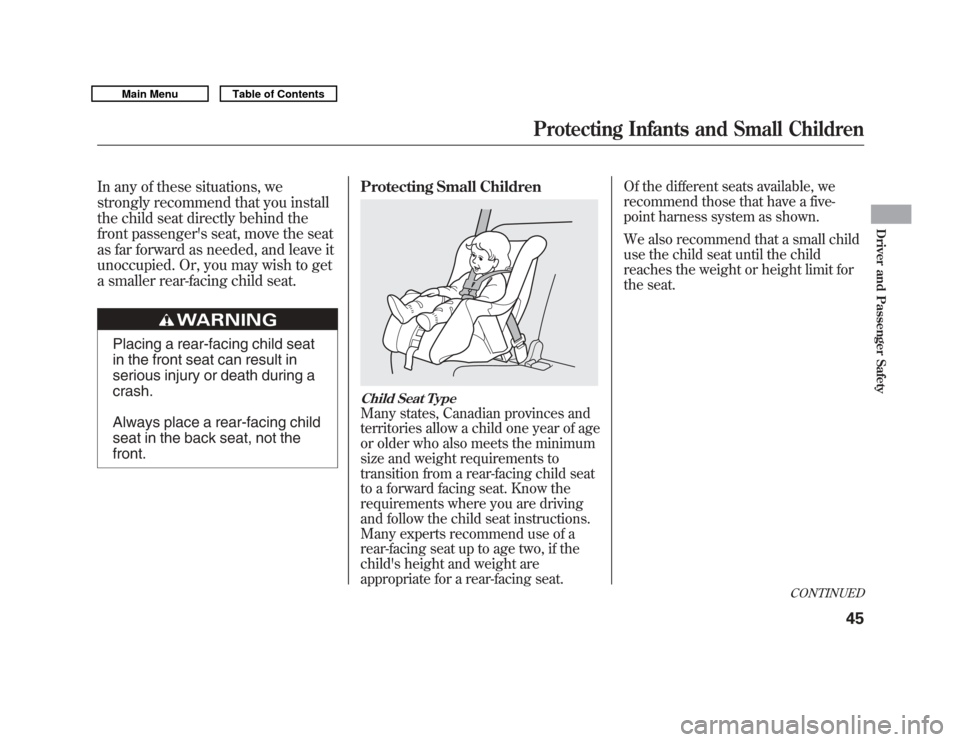
In any of these situations, we
strongly recommend that you install
the child seat directly behind the
front passenger's seat, move the seat
as far forward as needed, and leave it
unoccupied. Or, you may wish to get
a smaller rear-facing child seat.
Placing a rear-facing child seat
in the front seat can result in
serious injury or death during a
crash.
Always place a rear-facing child
seat in the back seat, not the
front.Protecting Small Children
Child Seat TypeMany states, Canadian provinces and
territories allow a child one year of age
or older who also meets the minimum
size and weight requirements to
transition from a rear-facing child seat
to a forward facing seat. Know the
requirements where you are driving
and follow the child seat instructions.
Many experts recommend use of a
rear-facing seat up to age two, if the
child's height and weight are
appropriate for a rear-facing seat. Of the different seats available, we
recommend those that have a five-
point harness system as shown.
We also recommend that a small child
use the child seat until the child
reaches the weight or height limit for
the seat.
CONTINUED
Protecting Infants and Small Children
45
Driver and Passenger Safety
10/06/29 11:59:04 11 ACURA MDX MMC North America Owner's M 50 31STX640 enu